
Star Trek is a worldwide phenomenon and, as StarTrek.com readers know, we occasionally present articles from the latest issues of Star Trek Magazine, which is published out of England and available internationally, and Inside Star Trek Magazine, the official Star Trek magazine of Italy. Today’s in-depth feature, written by Valerius Raimondi, is from Inside Trek Magazine and it examines the role of nature in Star Trek. The story below has been translated from Italian into English by the magazine’s editors, and we’ve lightly edited it further with an eye toward retaining the writer's original tone and rhythm.
Star Trek for us is always synonymous of future, technology, androids, starships... but is it just this? Our beloved television series is again a surprise... Star Trek shows us not just technologies but also what, in a free association of ideas and common sense, is its exact contrary: nature!
We actually often see our heroes dealing with plants, flowers, fruits and... just think about our Captain Kirk who - at the beginning of The Final Frontier - is climbing a mountain just... “because it’s there!”
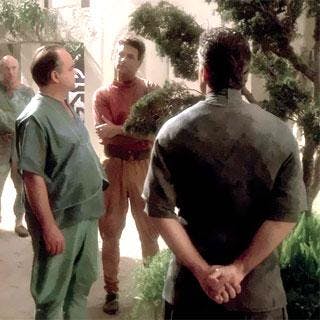
It is often among trees and forests that we see our heroes have their shore leaves, from Kirk, Spock and McCoy’s camping out in Yosemite, to Risa, where you can find all the environments for a relaxing vacation.
Star Trek thus offers us a vision of a future where technological progress embraces and gives value to nature from every point of view.

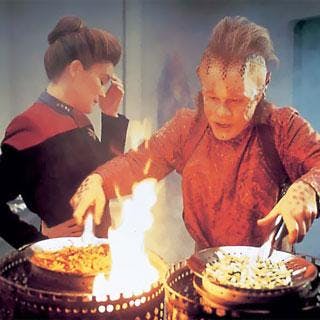
As we all know, however, Star Trek is populated by many alien species, like Odo, who said to Commander Sisko he wasn’t able to understand the sense of sacrificing various plants as a sign of affection during courting (“The Forsaken”). But aside these occasional cases, also in the technological future of Star Trek a flower always represents an emotion!
In Star Trek it’s a general rule to use the replicator in order to cook, but – as Voyager fans know so well - there are exceptions! Neelix soon changes himself from lonely merchant to on-board cook using all his knowledge of herbs, roots and tubers to prepare plates that the crew like... more or less. This fact shows that Star Trek, despite being a series set in the future, is not slave to technology. And if Riker wants to prepare an omelet, he uses a pan and some eggs, though maybe not the same used by Sisko for his Jambalaya!

Besides herbs, roots, tubers and various greeneries, we found also seeds and fruits, from the apples which raise suspicions in Riker (at the Farpoint station) to the rotten basketful of fruit on Picard’s shuttle during its collisions with temporal fissures. Nature provides the raw materials for more or less elaborate plates, but we cannot avoid mentioning the Jumja tree, which provides the sap needed to create a sweet delicacy very popular on the DS9 space station.
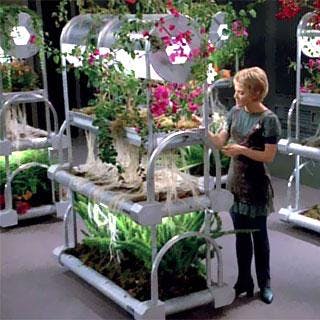

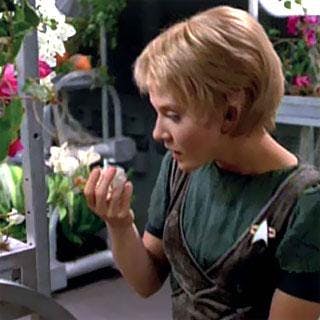
But what does a plant eat? Regardless of what type of plant it is, it needs a series of macro elements and a series of microelements. The first are so called not because they are big, but because they are the most important and the plant absorbs them in great quantities. They are nitrogen, phosphorus and potassium. We can find these elements in all fertilizers a good farmer uses for his plants, but they are also found in the soil. The microelements are so called because the plant needs very little of them, so little indeed that often during farming they are not even added to the soil because it has enough of them. Among the microelements, we can mention boron, calcium, magnesium and iron.
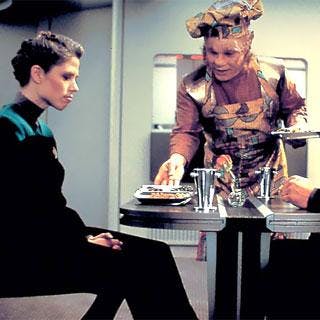
If a plant normally absorbs through its roots these elements in the soil, in hydroponics all this is substituted by water: the plant grows on an inert substrate (like mineral wool, coir or pearlite) that works just as a support for the plant (because, unlike the soil, it gives no nutrition to it). This substrate is continuously watered with a solution where there are quantities of micro and macro elements dissolved into it, enough to allow the plant to grow. Apparently it may seem a more complicated system compared to soil farming, and some think that it also has not the same quality, but there are many advantages in hydroponics. First of all it gives us the possibility to farm in areas and places where there is no fertile soil. Furthermore, it gives us a better control on plant nutrition, because we are the ones deciding what and how much nutrition to give it. Moreover, it allows us a better phytosanitary control, because in the soil there could be animal parasites or fungus that may attack the plant, spoiling it.
The water used to irrigate this hydroponics is balanced in quantity and quality of dissolved nutrients, but it’s not the only parameter to take into consideration. Other important parameters are pH, salinity, duration and frequency of the nutrition.
All this is firmly bonded to the type of plants we want to farm, because every species has its own nutritional needs. In a closed environment like a cargo hold, besides the water, we have to control air and light, which are equally important to make the plants grow well.
In Italy, this kind of farming is less applied than traditional soil farming and it’s used mainly to farm flowers or greeneries, exactly like in Star Trek!
Star Trek is nothing if not a message of hope for a better future, a more advanced future without illness, without wars, and with technology that supports all our needs... but the message that Star Trek really wants to send is not just that. It also teaches us to love each other, and to love our planet, to not neglect or damage it. It teaches a lesson that humanity has not learned well enough so far: to use technology, but respect nature and the environment, because in the future we will need both!
Click HERE to learn more about Inside Trek Magazine.

